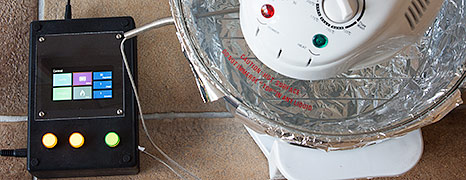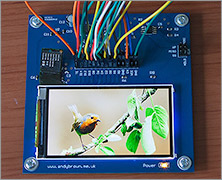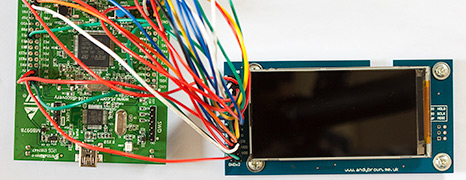Hello and welcome to another in my series of unique hardware projects designed to bring you something useful that you’ve hopefully never seen before and at a price point that any hobbyist can afford. This project brings together the knowledge that I’ve gained over the last few years to bring you a graphics accelerator for the Arduino Uno R3 based on an ARM Cortex M0 core attached to a 640×360 LCD from the Sony U5 Vivaz cellphone. In previous articles you’ve seen how I’ve reverse engineered the Sony LCD and then used it in reflow oven and FPGA graphics accelerator projects. Introduction TFT LCD shields for the...
An open-source Cortex-M0 halogen reflow oven controller with TFT LCD
posted by Andy
Introduction It’s been so long since I had the idea for this project that I can’t remember why I had the idea in the first place. At least I blame it on the passage of time although this engineer is getting on a bit now so it could easily be memory rot on my part. So here we are then, a reflow oven controller. Let’s quickly recap what a reflow oven is for those that are new around here. The two main processes used in industry to build printed circuit boards are wave soldering and reflow using a very large industrial oven that you probably can’t afford and if you could afford to buy it you probably couldn’t...
Reverse engineering the Sony Ericsson Vivaz high resolution 640 x 360 cellphone LCD
posted by Andy
Welcome to another in my series of cellphone LCD reverse-engineering articles. In this article I’m going to present everything you need to hook up the high-resolution 640×360 LCD from the Sony Ericsson U5 Vivaz to your project. About the phone and LCD The Sony Ericsson U5 Vivaz LCD...
Reverse engineering the LG KF700 480 x 240 widescreen cellphone LCD
posted by Andy
Hello and welcome to my first published non-Nokia cellphone LCD reverse-engineering effort. All my articles in this series focus on bringing you all of the details that you would need in order to connect a low-cost cellphone LCD to an MCU for use in your own projects. This one is no different. I will explain the pinout and the signals. I will tell you about the connector and where you can buy it and I will tell you about the controller IC and of course I will give away the complete source code driver for that controller. Let’s get started. The LG KF700 The KF700 was released in 2008 and is now a discontinued model. It featured a 3.0...
Reverse engineering the Nokia N95 8Gb QVGA LCD
posted by Andy
In this, the latest instalment of my Nokia QVGA TFT reverse engineering series, I will take on the 2.8 inch 24-bit TFT that is designed to work with the Nokia N95 8Gb mobile phone. Read on to see how it worked out. Background In the first of my reverse engineering articles I tackled the Nokia 2730 display. I successfully discovered enough of the command set to write a driver for the Arduino and the STM32. Flush with that success I moved on to tackle the Nokia 6300 and the Nokia N82. I was lucky in that these two shared the same pinout and command set as the 2730 so I could produce a development board with little difficulty. The N95...
Nokia N82 2.4 inch QVGA TFT on the Arduino
posted by Andy
It’s been a few months now since I released the original two articles that detailed the design, build and optimised software library for the 2.0″ Nokia 6300 QVGA TFT connected to the Arduino Mega XMEM interface. Judging by the responses I’ve had, there’s a lot of you...
Interfacing the Nokia 6300 QVGA TFT to the standard Arduino
posted by Andy
In two of my previous articles (here and here) I explained how we could connect the 8-bit 8080 interface presented by the TFT panel to the XMEM interface of the Arduino Mega to achieve a high performance full-colour graphical interface. I went on to present a high-performance open-source...
stm32plus: ILI9327 TFT driver
posted by Andy
The code presented in this article requires a minimum of version 3.0.0 of my stm32plus library. The TFT panel The ILI9327 is a driver IC for 432×240 (WQVGA) panels. The panels are typically found in mobile phones; LG went through a phase of producing lots of phones with...








